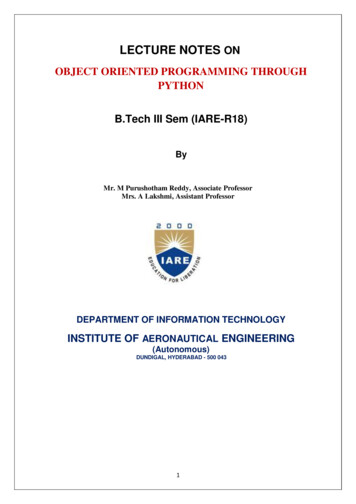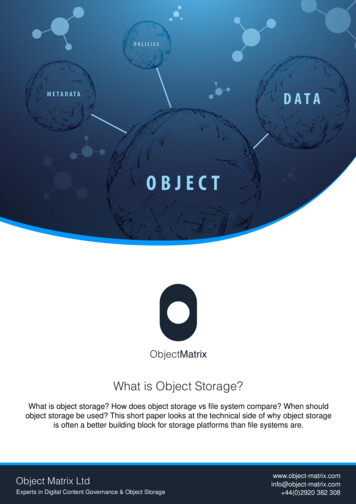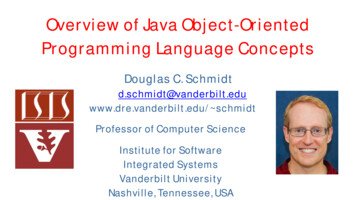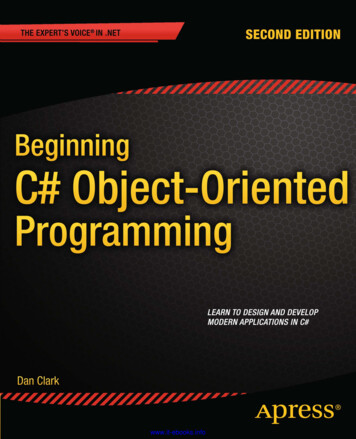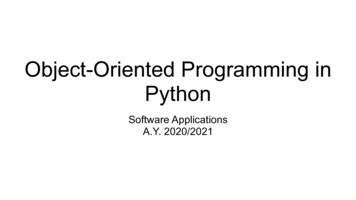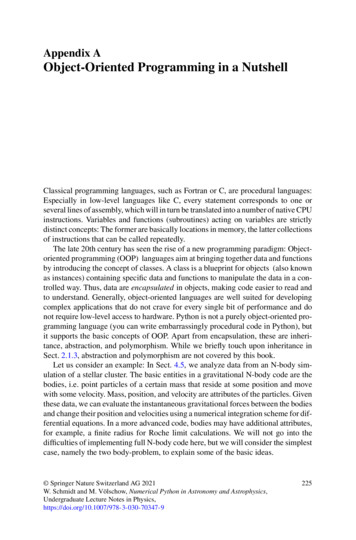
Transcription
The Object-OrientedThought ProcessThird Edition
Developer’s LibraryESSENTIAL REFERENCES FOR PROGRAMMING PROFESSIONALSDeveloper’s Library books are designed to provide practicing programmers withunique, high-quality references and tutorials on the programming languages andtechnologies they use in their daily work.All books in the Developer’s Library are written by expert technology practitionerswho are especially skilled at organizing and presenting information in a way that’suseful for other programmers.Key titles include some of the best, most widely acclaimed books within theirtopic areas:PHP & MySQL Web DevelopmentPython Essential ReferenceLuke Welling & Laura ThomsonISBN 978-0-672-32916-6David BeazleyISBN-13: 978-0-672-32862-6MySQLProgramming in Objective-CPaul DuBoisISBN-13: 978-0-672-32938-8Stephen G. KochanISBN-13: 978-0-321-56615-7Linux Kernel DevelopmentPostgreSQLRobert LoveISBN-13: 978-0-672-32946-3Korry DouglasISBN-13: 978-0-672-33015-5Developer’s Library books are available at most retail and online bookstores, as wellas by subscription from Safari Books Online at m/devlibrary
The Object-OrientedThought ProcessThird EditionMatt WeisfeldUpper Saddle River, NJ Boston Indianapolis San FranciscoNew York Toronto Montreal London Munich Paris MadridCape Town Sydney Tokyo Singapore Mexico City
The Object-Oriented Thought Process, Third EditionCopyright 2009 by Pearson EducationAll rights reserved. No part of this book shall be reproduced, stored in a retrieval system, ortransmitted by any means, electronic, mechanical, photocopying, recording, or otherwise,without written permission from the publisher. No patent liability is assumed with respect tothe use of the information contained herein. Although every precaution has been taken inthe preparation of this book, the publisher and author assume no responsibility for errors oromissions. Nor is any liability assumed for damages resulting from the use of the information contained herein.ISBN-10: 0-672-33016-4ISBN-13: 978-0-672-33016-2Library of Congress Cataloging-in-Publication DataWeisfeld, Matt A.The object-oriented thought process / Matt Weisfeld. -- 3rd ed.p. cm.Includes index.ISBN 978-0-672-33016-2 (pbk.)1. Object-oriented programming (Computer science) I. Title.QA76.64.W436 2009005.1'17--dc222008027242Printed in the United States of AmericaFirst Printing: August 2008TrademarksAll terms mentioned in this book that are known to be trademarks or service marks havebeen appropriately capitalized. Sams Publishing cannot attest to the accuracy of this information. Use of a term in this book should not be regarded as affecting the validity of anytrademark or service mark.Warning and DisclaimerEvery effort has been made to make this book as complete and as accurate as possible,but no warranty or fitness is implied. The information provided is on an “as is” basis. Theauthor and the publisher shall have neither liability nor responsibility to any person or entitywith respect to any loss or damages arising from the information contained in this book orfrom the use of the programs accompanying it.Bulk SalesPearson offers excellent discounts on this book when ordered in quantity for bulkpurchases or special sales. For more information, please contactU.S. Corporate and Government or sales outside of the U.S., please contactInternational Salesinternational@pearsoned.comAcquisitions EditorMark TaberDevelopmentEditorSonglin QiuManaging EditorPatrick KanouseProject EditorSeth KerneyCopy EditorChrissy WhiteIndexerTim WrightProofreaderMatt PurcellTechnical EditorJon UpchurchPublishingCoordinatorVanessa EvansBook DesignerGary AdairCompositionMark Shirar
ContentsContents at a GlanceIntroduction11 Introduction to Object-Oriented Concepts2 How to Think in Terms of Objects373 Advanced Object-Oriented Concepts4 The Anatomy of a Class755 Class Design Guidelines876 Designing with Objects5531037 Mastering Inheritance and Composition1298 Frameworks and Reuse: Designing with Interfacesand Abstract Classes 1519 Building Objects17910 Creating Object Models with UML11 Objects and Portable Data: XML19320712 Persistent Objects: Serialization and RelationalDatabases 22513 Objects and the Internet24714 Objects and Client/Server Applications15 Design PatternsIndex309287271v
Table of ContentsIntroduction11 Introduction to Object-Oriented ConceptsProcedural Versus OO Programming56Moving from Procedural to Object-Oriented DevelopmentProcedural ProgrammingOO Programming910What Exactly Is an Object?Object Data1010Object Behaviors11What Exactly Is a Class?14Classes Are Object TemplatesAttributes91517Methods17Messages17Using UML to Model a Class DiagramEncapsulation and Data HidingInterfaces181919Implementations20A Real-World Example of the Interface/ImplementationParadigm 20A Model of the Interface/Implementation Paradigm21Inheritance22Superclasses and SubclassesAbstractionIs-a ion29Has-a RelationshipsConclusion23232929Example Code Used in This Chapter302 How to Think in Terms of Objects37Knowing the Difference Between the Interface and theImplementation 38The Interface40
The Implementation40An Interface/Implementation Example41Using Abstract Thinking When Designing InterfacesGiving the User the Minimal Interface PossibleDetermining the UsersObject Behavior4848Identifying the Public Interfaces49Identifying the Implementation50References51503 Advanced Object-Oriented ConceptsConstructors4748Environmental ConstraintsConclusion455353The Default Constructor54When Is a Constructor Called?What’s Inside a Constructor?The Default Constructor545454Using Multiple Constructors55The Design of Constructors59Error Handling60Ignoring the Problem60Checking for Problems and Aborting the Application60Checking for Problems and Attempting to Recover61Throwing an ExceptionThe Concept of ScopeLocal Attributes6364Object Attributes65Class Attributes67Operator OverloadingMultiple InheritanceObject OperationsConclusion71References7161686970Example Code Used in This Chapter4 The Anatomy of a ClassThe Name of the ClassComments77757572
Attributes77ConstructorsAccessors7980Public Interface Methods83Private Implementation MethodsConclusion84References8483Example Code Used in This Chapter5 Class Design Guidelines8487Modeling Real World Systems87Identifying the Public Interfaces88The Minimum Public InterfaceHiding the Implementation8889Designing Robust Constructors (and Perhaps Destructors)89Designing Error Handling into a Class90Documenting a Class and Using Comments91Building Objects with the Intent to CooperateDesigning with Reuse in MindDocumenting a Class and Using CommentsDesigning with Extensibility in MindMaking Names Descriptive93Providing a Way to Copy and Compare ObjectsKeeping the Scope as Small as Possible94A Class Should Be Responsible for Itself95Designing with Maintainability in MindUsing Object Persistence9799Serializing and Marshaling ObjectsConclusion100References1019697Testing the Interface919292Abstracting Out Nonportable CodeUsing Iteration9191Example Code Used in This Chapter10010193
6 Designing with ObjectsDesign Guidelines103103Performing the Proper Analysis107Developing a Statement of WorkGathering the Requirements107107Developing a Prototype of the User InterfaceIdentifying the Classes108108Determining the Responsibilities of Each Class108Determining How the Classes Collaborate with EachOther 109Creating a Class Model to Describe the SystemCase Study: A Blackjack ExampleUsing CRC Cards109111Identifying the Blackjack Classes112Identifying the Classes’ Responsibilities115UML Use-Cases: Identifying the CollaborationsFirst Pass at CRC Cards124UML Class Diagrams: The Object ModelPrototyping the User 29130Generalization and SpecializationDesign DecisionsComposition1261277 Mastering Inheritance and CompositionReusing Objects133134135Representing Composition with UML136Why Encapsulation Is Fundamental to OO138How Inheritance Weakens EncapsulationA Detailed Example of PolymorphismObject xample Code Used in This Chapter139146120
xContents8 Frameworks and Reuse: Designing with Interfacesand Abstract Classes 151Code: To Reuse or Not to Reuse?What Is a Framework?What Is a Contract?153Abstract Classes154Interfaces151152157Tying It All Together159The Compiler ProofMaking a Contract161162System Plug-in-PointsAn E-Business Example165165An E-Business Problem165The Non-Reuse Approach166An E-Business Solution168The UML Object Model168Conclusion173References173Example Code Used in This Chapter9 Building Objects173179Composition RelationshipsBuilding in Phases179181Types of CompositionAggregations183Associations184183Using Associations and Aggregations TogetherAvoiding DependenciesCardinality186186Multiple Object AssociationsOptional AssociationsTying It All Together: An ExampleConclusion192References19218919019110 Creating Object Models with UMLWhat Is UML?193193The Structure of a Class Diagram194185
ContentsAttributes and MethodsAttributes196Methods197Access 204Conclusion205References20511 Objects and Portable Data: XMLPortable Data207207The Extensible Markup Language (XML)XML Versus HTML209209XML and Object-Oriented Languages210Sharing Data Between Two Companies211Validating the Document with the Document TypeDefinition (DTD) 212Integrating the DTD into the XML DocumentUsing Cascading Style SheetsConclusion223References22321322012 Persistent Objects: Serialization and RelationalDatabases 225Persistent Objects Basics225Saving the Object to a Flat FileSerializing a File227227Implementation and Interface RevisitedWhat About the Methods?231Using XML in the Serialization ProcessWriting to a Relational Database238Making the ConnectionThe SQL Statements238239231234Accessing a Relational DatabaseLoading the Driver229236xi
xiiContentsConclusion242References242Example Code Used in This Chapter13 Objects and the Internet247Evolution of Distributed ComputingObject-Based Scripting LanguagesA JavaScript Validation ExampleObjects in a Web Page247248250253JavaScript Objects254Web Page Controls255Sound Players257Movie Players257Flash242258Distributed Objects and the Enterprise258The Common Object Request Broker Architecture(CORBA) 259Web Services DefinitionWeb Services eferences27014 Objects and Client/Server ApplicationsClient/Server ApproachesProprietary Approach272Serialized Object CodeClient Code271271272273Server Code275Running the Proprietary Client/Server ExampleNonproprietary ApproachObject Definition CodeClient Code278280Server Code281Running the Nonproprietary Client/Server ExampleConclusion276278283283
References284Example Code Used in This Chapter15 Design Patterns287Why Design Patterns?288Smalltalk’s Model/View/ControllerTypes of Design Patterns291Structural Patterns295Behavioral Patterns298299Conclusion300References300Example Code Used in This ChapterIndex309289290Creational PatternsAntipatterns284301
About the AuthorMatt Weisfeld is an associate professor in business & technology at CuyahogaCommunity College (Tri-C) in Cleveland, Ohio. A member of the InformationTechnology faculty, he focuses on programming, web development, and entrepreneurship. Prior to joining Tri-C,Weisfeld spent 20 years in the information technology industry gaining experience in software development, project management, small businessmanagement, corporate training, and part-time teaching. He holds an MS in computerscience and an MBA in project management. Besides the first two editions of The ObjectOriented Thought Process, he has published two other computer books and articles in magazines and journals such as developer.com, Dr. Dobb’s Journal, The C/C Users Journal,Software Development Magazine, Java Report, and the international journal ProjectManagement.
DedicationTo Sharon, Stacy, Stephanie, and DuffyAcknowledgmentsAs with the first two editions, this book required the combined efforts of many people. Iwould like to take the time to acknowledge as many of these people as possible, forwithout them, this book would never have happened.First and foremost, I would like to thank my wife Sharon for all of her help. Not onlydid she provide support and encouragement throughout this lengthy process, she is alsothe first line editor for all of my writing.I would also like to thank my mom and the rest of my family for their continuedsupport.I have really enjoyed working with the people at Pearson on all three editions of thisbook.Working with editors Mark Taber, Seth Kerney,Vanessa Evans, and Songlin Qiu hasbeen a pleasure.A special thanks goes to Jon Upchurch for his help with much of the code as well asthe technical editing of the manuscript.Finally, thanks to my daughters, Stacy and Stephanie, and my cat Duffy for keepingme on my toes.
We Want to Hear from You!As the reader of this book, you are our most important critic and commentator.We valueyour opinion and want to know what we’re doing right, what we could do better, whatareas you’d like to see us publish in, and any other words of wisdom you’re willing topass our way.You can email or write me directly to let me know what you did or didn’t like aboutthis book—as well as what we can do to make our books stronger.Please note that I cannot help you with technical problems related to the topic of this book, andthat due to the high volume of mail I receive, I might not be able to reply to every message.When you write, please be sure to include this book’s title and author as well as yourname and phone or email address. I will carefully review your comments and share themwith the author and editors who worked on the rk TaberAssociate PublisherPearson Education800 East 96th StreetIndianapolis, IN 46240 USAReader ServicesVisit our website and register this book at informit.com forconvenient access to any updates, downloads, or errata that might be available forthis book.
IntroductionThis Book’s ScopeAs the title indicates, this book is about the object-oriented (OO) thought process. Obviously, choosing the theme and title of the book are important decisions; however, thesedecisions were not all that simple. Numerous books deal with various levels of object orientation. Several popular books deal with topics including OO analysis, OO design, OOprogramming, design patterns, OO data (XML), the Unified Modeling Language (UML),OO Internet development, various OO programming languages, and many other topicsrelated to OO development.However, while pouring over all of these books, many people forget that all of thesetopics are built on a single foundation: how you think in OO ways. It is unfortunate, butsoftware professionals often dive into these books without taking the appropriate timeand effort to really understand the concepts behind the content.I contend that learning OO concepts is not accomplished by learning a specific development method or a set of tools. Doing things in an OO manner is, simply put, a way ofthinking.This book is all about the OO thought process.Separating the methods and tools from the OO thought process is not easy. Many people are introduced to OO concepts via one of these methods or tools. For example, yearsago, most C programmers were first introduced to object orientation by migrating directly to C —before they were even remotely exposed to OO concepts. Other software professionals were first introduced to object orientation by presentations thatincluded object models using UML—again, before they were even exposed directly toOO concepts. It is not unusual to find that programming books and courses defer OOconcepts until later in the learning process.It is important to understand the significant difference between learning OO conceptsand using the methods and tools that support the paradigm.This came into focus for mebefore I worked on the first edition of this book when I read articles such as Craig Larman’s “What the UML Is—and Isn’t,” In this article he states,Unfortunately, in the context of software engineering and the UML diagramming language,acquiring the skills to read and write UML notation seems to sometimes be equated withskill in object-oriented analysis and design. Of course, this is not so, and the latter is muchmore important than the former. Therefore, I recommend seeking education and educationalmaterials in which intellectual skill in object-oriented analysis and design is paramountrather than UML notation or the use of a case tool.
2IntroductionAlthough learning a modeling language is an important step, it is much more important to learn OO skills first. Learning UML before OO concepts is similar to learninghow to read an electrical diagram without first knowing anything about electricity.The same problem occurs with programming languages. As stated earlier, many Cprogrammers moved into the realm of object orientation by migrating to C beforebeing directly exposed to OO concepts.This would always come out in an interview.Many times developers who claim to be C programmers are simply C programmersusing C compilers. Even now, with languages such as C# .NET,VB .NET, and Javawell established, a few key questions in a job interview can quickly uncover a lack ofOO understanding.Early versions of Visual Basic are not OO. C is not OO, and C was developed to bebackward compatible with C. Because of this, it is quite possible to use a C compiler(writing only C syntax) while forsaking all of C ’s OO features. Even worse, a programmer can use just enough OO features to make a program incomprehensible to OOand non-OO programmers alike.Thus, it is of vital importance that while you’re on the road to OO development, youfirst learn the fundamental OO concepts. Resist the temptation to jump directly into aprogramming language (such as VB .NET, C , C# .NET or Java) or a modeling language (such as UML), and take the time to learn the object-oriented thought process.In my first class in Smalltalk in the late 1980s, the instructor told the class that the newOO paradigm was a totally new way of thinking (despite the fact that it has been around sincethe 60s). He went on to say that although all of us were most likely very good programmers, about 10%–20% of us would never really grasp the OO way of doing things. If thisstatement is indeed true, it is most likely because some people never really take the timeto make the paradigm shift and learn the underlying OO concepts.What’s New in the Third EditionAs stated often in this introduction, my vision for the first edition was primarily a conceptual book.Although I still adhere to this goal for the second and third editions, I haveincluded several application topics that fit well with object-oriented concepts. For thethird edition I expand on many of the topics of the second edition and well as includetotally new chapters.These revised and updated conceptsnnnnnnnXML is used for object communication.Object persistence and serialization.XML integrated into the languages object definition.Adding properties to attributes.XML-based Internet applications.Client/Server technologies.Expanded code examples in Java, C# .NET and VB .NET.
This Book’s ScopeThe chapters that cover these topics are still conceptual in nature; however, many of thechapters include Java code that shows how these concepts are implemented. In this thirdedition, a code appendix is included that presents the chapter’s examples in C# .NET andVisual Basic .NET.The Intended AudienceThis book is a general introduction to fundamental OO concepts with code examples toreinforce the concepts. One of the most difficult juggling acts was to keep the materialconceptual while still providing a solid, technical code base.The goal of this book is to allow a reader to understand the concepts and technology without having a compiler athand. However, if you do have a compiler available, then there is code to be investigated.The intended audience includes business managers, designers, developers, programmers, project managers, and anyone who wants to gain a general understanding of whatobject orientation is all about. Reading this book should provide a strong foundation formoving to other books covering more advanced OO topics.Of these more advanced books, one of my favorites remains Object-Oriented Design inJava by Stephen Gilbert and Bill McCarty. I really like the approach of the book, and haveused it as a textbook in classes I have taught on OO concepts. I cite Object-Oriented Design in Java often throughout this book, and I recommend that you graduate to it afteryou complete this one.Other books that I have found very helpful include Effective C by Scott Meyers,Classical and Object-Oriented Software Engineering by Stephen R. Schach, Thinking in C by Bruce Eckel, UML Distilled by Martin Flower, and Java Design by Peter Coad andMark Mayfield.The conceptual nature of this book provides a unique perspective in regards to othercomputer technology books.While books that focus on specific technologies, such asprogramming languages, struggle with the pace of change, this book has the luxury ofpresenting established concepts that, while certainly being fine-tuned, do not experienceradical changes.With this in mind, many of the books that were referenced several yearsago, are still referenced because the concepts are still fundamentally the same.This Book’s ScopeIt should be obvious by now that I am a firm believer in becoming comfortable with theobject-oriented thought process before jumping into a programming language or modeling language.This book is filled with examples of code and UML diagrams; however, youdo not need to know a specific programming language or UML to read it.After all I havesaid about learning the concepts first, why is there so much Java, C# .NET, and VB .NETcode and so many UML diagrams? First, they are all great for illustrating OO concepts.Second, both are vital to the OO process and should be addressed at an introductorylevel.The key is not to focus on Java, C# .NET, and VB .NET or UML, but to use themas aids in the understanding of the underlying concepts.3
4IntroductionThe Java, C# .NET and VB .NET examples in the book illustrate concepts such asloops and functions. However, understanding the code itself is not a prerequisite for understanding the concepts; it might be helpful to have a book at hand that covers specificlanguages syntax if you want to get more detailed.I cannot state too strongly that this book does not teach Java, C# .NET, and VB .NETor UML, all of which can command volumes unto themselves. It is my hope that thisbook will whet your appetite for other OO topics, such as OO analysis, object-orienteddesign, and OO programming.This Book’s ConventionsThe following conventions are used in this book:nnnCode lines, commands, statements, and any other code-related terms appear in amonospace typeface.Placeholders that stand for what you should actually type appear in italic monospace.Text that you should type appears in bold monospace.Throughout the book, there are special sidebar elements, such asNoteA Note presents interesting information related to the discussion—a little more insight or apointer to some new technique.TipA Tip offers advice or shows you an easier way of doing something.CautionA Caution alerts you to a possible problem and gives you advice on how to avoid it.Source Code Used in This BookYou can download all the source code and examples discussed within this book from thepublisher’s website.
1Introduction toObject-Oriented ConceptsAlthough many people find this bit of information surprising, object-oriented (OO)software development has been around since the early 1960s. Objects are now usedthroughout the software development industry. It is no secret that the software industrycan be slow-moving at times. It is also true that, when systems are working fine, there hasto be a compelling reason to replace them.This has somewhat slowed the propagation ofOO systems.There are many non-OO legacy systems (that is, older systems that are alreadyin place) that are doing the job—so why risk potential disaster by changing them? Inmost cases you should not change them, at least not simply for the sake of change.Thereis nothing inherently wrong with systems written in non–OO code. However, brand-newdevelopment definitely warrants the consideration of using OO technologies.Although there has been a steady and significant growth in OO development in thepast 15 years, the continued reliance on the Internet has helped catapult it even furtherinto the mainstream.The emergence of day-to-day business transactions on the Internethas opened a brand-new arena, where much of the software development is new andmostly unencumbered by legacy concerns. Even when there are legacy concerns, there isa trend to wrap the legacy systems in object wrappers.Object WrappersObject wrappers are object-oriented code that includes other code inside. For example, youcan take a structured module and wrap it inside an object to make it look like an object. Youcan also use object wrappers to wrap functionality such as security features, non-portablehardware features, and so on.Today, one of the most interesting areas of software development is the marriage of legacyand Internet based systems. In many cases, a web-based front-end ultimately connects todata that resides on a Mainframe. Developers who can combine the skills of mainframeand web development are in demand.
6Chapter 1 Introduction to Object-Oriented ConceptsObjects have certainly made their way into our personal and professional informationsystems (IS) lives—and they cannot be ignored.You probably experience objects in yourdaily like without even knowing it.These experiences can take place in your car, talkingon your cell phone, using your digital TV, and many other situations.With the success of Java, Microsoft’s .NET technologies and many others, objects arebecoming a major part of the technology equation.With the explosion of the Internet,and countless local networks, the electronic highway has in essence become an objectbased highway (in the case of wireless, object-based signals).As businesses gravitate towardthe Web, they are gravitating toward objects because the technologies used for electroniccommerce are mostly OO in nature.This chapter is an overview of the fundamental OO concepts.The concepts coveredhere touch on most, if not all, of the topics covered in subsequent chapters, which explorethese issues in much greater detail.Procedural Versus OO ProgrammingBefore we delve deeper into the advantages of OO development, let’s consider a morefundamental question:What exactly is an object? This is both a complex and a simplequestion. It is complex because learning any method of software development is not trivial. It is simple because people already think in terms of objects.For example, when you look at a person, you see the person as an object.And an object is defined by two terms: attributes and behaviors.A person has attributes, such as eyecolor, age, height, and so on.A person also has behaviors, such as walking, talking, breathing, and so on. In its basic definition, an object is an entity that contains both data and behavior.The word both is the key difference between OO programming and otherprogramming methodologies. In procedural programming, for example, code is placedinto totally distinct functions or procedures. Ideally, as shown in Figure 1.1, these procedures then become “black boxes,” where inputs go in and outputs come out. Data isplaced into separate structures and is manipulated by these functions or procedures.InputsOutputsFigure 1.1Black boxes.Difference Between OO and ProceduralIn OO design, the attributes and behaviors are contained within a single object, whereas inprocedural, or structured design, the attributes and behaviors are normally separated.
Procedural Versus OO ProgrammingAs OO design grew in popularity, one of the realities that slowed its acceptance was thefact that there were a lot of non-OO systems in place that worked perfectly fine.Thus, itdid not make any business sense to simply change the systems for the sake of change.Anyone who is familiar with any computer system knows that any change can spell disaster—even if the change is perceived to be slight.This situation came into play with the lack of acceptance of OO databases.At onepoint in the acceptance of OO development it seemed somewhat likely that OO databases would replace relational databases. However, this never happened. Businesses had alot of money invested in relational databases, and there was one overriding factor—theyworked.When all of the costs and risks of converting systems from relational to OO databases became apparent, there was no compelling reason to switch.In fact, the business forces have now found a happy middle ground. Much of the software development practices today have flavors of several development methodologies suchas OO and structured.As illustrated in Figure 1.2, in structured programming the data is often separated fromthe procedures, and sometimes the data is global, so it is easy to modify data that is outsidethe scope of your code.This means that access to data is uncontrolled and unpredictable(that is, multiple functions may have access to the global data). Second, because you haveno control over who has access to the data, testing and debugging are much more difficult. Objects address these problems by combining data and behavior into a nice, completepackage.Function 1Function 2Global DataFunction 3Figure 1.2F
Contents v Contents at a Glance Introduction 1 1 Introduction to Object-Oriented Concepts5 2 How to Think in Terms of Objects 37 3 Advanced Object-Oriented Concepts 53 4 The Anatomy of a Class 75 5 Class Design Guidelines 87 6 Designing with Objects 103 7 Mastering Inheritance and Composition129 8 Frameworks and Reuse: Designing with Interfaces and Abstract Classes 151 9 Building Objects 179


